Related Research Articles
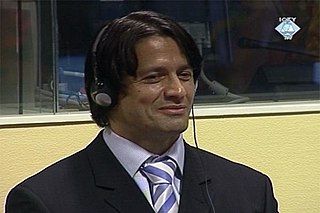
Naser Orić is a former Bosnian military officer who commanded Army of the Republic of Bosnia and Herzegovina (ARBiH) forces in the Srebrenica enclave in eastern Bosnia surrounded by Bosnian Serb forces, during the Bosnian War.

The Implementation Force (IFOR) was a NATO-led multinational peace enforcement force in Bosnia and Herzegovina under a one-year mandate from 20 December 1995 to 20 December 1996 under the codename Operation Joint Endeavour.

The Srebrenica massacre, also known as the Srebrenica genocide, was the July 1995 genocidal killing of more than 8,000 Bosniak Muslim men and boys in and around the town of Srebrenica, during the Bosnian War. The killings were perpetrated by units of the Bosnian Serb Army of Republika Srpska (VRS) under the command of Ratko Mladić. The Scorpions, a paramilitary unit from Serbia, who had been part of the Serbian Interior Ministry until 1991, also participated in the massacre.
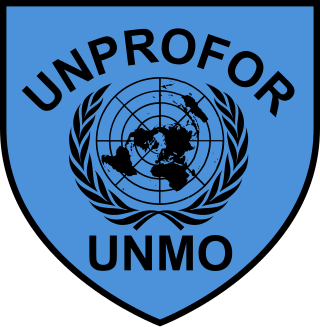
The United Nations Protection Force was the first United Nations peacekeeping force in Croatia and in Bosnia and Herzegovina during the Yugoslav Wars. The force was formed in February 1992 and its mandate ended in March 1995, with the peacekeeping mission restructuring into three other forces.
Philippe Morillon is a former French general and was a Member of the European Parliament until 2009. He was elected on the Union for French Democracy ticket with the Alliance of Liberals and Democrats for Europe group. On 23 July 2004 he was elected Chair of the Committee on Fisheries.

Operation Deliberate Force was a sustained air campaign conducted by NATO, in concert with the UNPROFOR ground operations, to undermine the military capability of the Army of Republika Srpska, which had threatened and attacked UN-designated "safe areas" in Bosnia and Herzegovina during the Bosnian War with the Srebrenica genocide and Markale massacres, precipitating the intervention. The shelling of the Sarajevo marketplace on 28 August 1995 by the VRS is considered to be the immediate instigating factor behind NATO's decision to launch the operation.

United Nations Safe Areas were humanitarian corridors established in 1993 in the territory of Bosnia and Herzegovina during the Bosnian War by several resolutions of the United Nations Security Council.

Radislav Krstić is a former Bosnian Serb Deputy Commander and later Chief of Staff of the Drina Corps of the Army of Republika Srpska from October 1994 until 12 July 1995. He was promoted to the rank of major general in June 1995 and assumed command of the Drina Corps on 13 July 1995.

Thomas Jakob Peter Karremans is the former commander of Dutchbat troops in Srebrenica at the time of the Srebrenica genocide during the Bosnian War. Dutchbat had been assigned to defend the Bosniak enclave made the U.N. "safe area", but it failed to prevent the Serbs from taking the city.
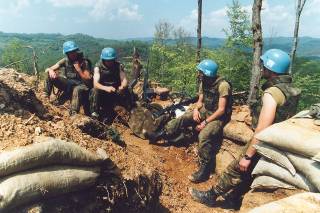
Dutchbat was a Dutch battalion under the command of the United Nations in operation UNPROFOR. It was hastily formed out of the emerging 11th Airmobile Brigade between February 1994 and November 1995 to participate in peacekeeping operations. It was tasked to execute United Nations Security Council Resolution 819 in the Bosnian Muslim enclaves and the designated UN "safe havens" of Srebrenica and Žepa during the Bosnian War.
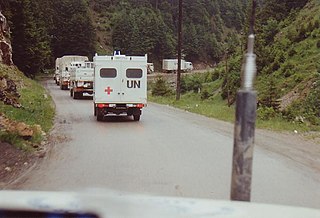
The Operation Bøllebank is the name given to the military confrontation between Bosnian Serb military forces and Danish, Norwegian, and Swedish combat units composing the United Nations Protection Force's (UNPROFOR) Nordic Battalion, outside of the city of Tuzla on 29 April 1994.

Guy Ludvic Sands-Pingot is a retired officer of the United States Army who has served as brigadier general of the United States Army Reserve. He served as commander of the 353rd Civil Affairs Command located at Fort Wadsworth, New York from 3 December 2005 through 6 December 2008.

The siege of Srebrenica was a three-year siege of the town of Srebrenica in eastern Bosnia and Herzegovina which lasted from April 1992 to July 1995 during the Bosnian War. Initially assaulted by the Yugoslav People's Army (JNA) and the Serbian Volunteer Guard (SDG), the town was encircled by the Army of Republika Srpska (VRS) in May 1992, starting a brutal siege which was to last for the majority of the Bosnian War. In June 1995, the commander of the Army of the Republic of Bosnia and Herzegovina (ARBiH) in the enclave, Naser Orić, left Srebrenica and fled to the town of Tuzla. He was subsequently replaced by his deputy, Major Ramiz Bećirović.

United Nations Security Council resolution 1004, adopted unanimously on 12 July 1995, after recalling all resolutions on the situation in the former Yugoslavia, the council, acting under Chapter VII of the United Nations Charter, demanded that Bosnian Serb forces withdraw from the safe area of Srebrenica in Bosnia and Herzegovina and respect the safety of personnel from the United Nations Protection Force (UNPROFOR). The resolution was passed during the Srebrenica massacre.
Avdo Palić was a Bosnian military officer during the 1992–1995 war in Bosnia and Herzegovina. Palić held the rank of colonel in the Army of the Republic of Bosnia and Herzegovina (ARBiH) and commanded the Bosnian government forces in the enclave of Žepa during the entire 40-month-long siege.

Bernard Janvier is a former general of the French Army who served in the French Foreign Legion, primarily spearheading and putting in place effective resolving forces.

The Utility of Force: The Art of War in the Modern World is a treatise on modern warfare written by General Sir Rupert Smith and published in 2005. Smith is a retired general who spent 40 years in the British Army; he commanded the 1st Armoured Division in the First Gulf War and served as General Officer Commanding Northern Ireland at the end of the Troubles. He was motivated to write the book by his experiences in the Balkans. He commanded the United Nations Protection Force (UNPROFOR) in Bosnia from 1995 to 1996, during which time the Srebrenica massacre occurred and the capital, Sarajevo, was under siege by Serb forces. Smith was instrumental in the lifting of the siege by arranging for NATO air strikes and an artillery barrage. This enabled a ground assault by Bosnian and Croatian forces that ended the siege and led to the Dayton Agreement. Smith's second involvement with the Balkans was in 1999 during the Kosovo War, when he was serving as NATO's Deputy Supreme Allied Commander Europe, overseeing air strikes against Serb targets.
Senior Colonel Ulf Hugo Henricsson is a former Swedish officer. He is best known for his achievements in the Bosnian War as commander of the peacekeeping operations from September 1993 to April 1994. There he commanded the Nordic battalion which was a part of the United Nations Protection Force (UNPROFOR).

Michael Beary is a retired Irish Army Major general and former head of mission and force commander of the United Nations Interim Force in Lebanon (UNIFIL). Beary is the current leader of the UN Mission to Support the Hodeidah Agreement having retired from the military.
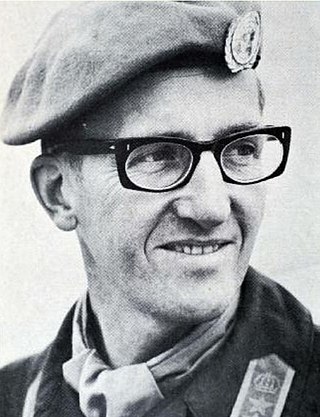
Lieutenant General Lars-Eric Malcom Wahlgren was a Swedish Army officer. Wahlgren served as commanding officer of Gotland Military Command, as Chief of Home Guard and as Force Commander of the United Nations Interim Force in Lebanon (UNIFIL) and the United Nations Protection Force (UNPROFOR)
References
- 1 2 Norsk oberst får kritikk etter folkemord
- ↑ "Norway to Facilitate Talks between the Government of Sri Lanka and the Liberation Tigers". Norway - the official site in the United States.
- 1 2 Norske FN-soldater hjalp libanesiske fanger unna israelerne
- 1 2 Report: UNIFIL helped prisoners flee IDF
- ↑ "The fall of Srebrenica". Netherlands Institute for War Documentation. p. Part III chapter 9.6. Retrieved 2013-04-10.
- 1 2 3 4 5 "– Forsøker å skjule sannheten". Ny Tid . 24 September 2005. Archived from the original on 22 February 2014.
- 1 2 Eraker, Harald (13 July 2006). "Styrken som sviktet (The force that failed)". Ny Tid (in Norwegian). Ny Tid & Orientering AS. Retrieved 30 October 2015.